InterviewSolution
This section includes InterviewSolutions, each offering curated multiple-choice questions to sharpen your knowledge and support exam preparation. Choose a topic below to get started.
| 4351. |
If radius of circular paths followed by one proton and one alpha-particle, in the plane, perpendicular to uniform magnetic field, are equal then ratio of their momenta is _____ . |
|
Answer» `1:1` `r=(mv)/(Bq)=p/(Bq)` `therefore` In p = BQR, B and r same `thereforeppropq` `thereforep_(p)/p_(ALPHA)=q_(p)/q_(alpha)=e/(2e)=1/2` `thereforep_(p):p_(alpha)=1:2` |
|
| 4352. |
At the corners A, B, C of a square ABCD, charges 10mC, -20mC and 10mC are placed. The electric intensity at the centre of the square to become zero, the charge to be placed at the corner D is |
|
Answer» `-20MC` |
|
| 4353. |
An electron enters a region of space in which there exists an electric field 'E' and magnetic field 'B'. If the electron continues to move in the same direction with same velocity as before, the NOT possible case among the following is |
|
Answer» E = 0 & B=0 |
|
| 4354. |
Which of the wavelength of the sun is used finally as electric energy ? |
|
Answer» RADIO waves |
|
| 4355. |
A : Magnifying power of a simple microscope cannot be increased beyond a limit. R : Magnifying power is inversely proportional to focal length and there are some practical difficulty of grinding, aberrations etc. because of which focal length cannot be decreased below a limt. |
|
Answer» If both Assertion & Reason are true and the reason is the correct explanation of the assertion, then mark (1). |
|
| 4356. |
Statement I : Smaller drops of liquid resist deforming forces better than bigger drops. Statement II : The value of excess pressure inside a drop is directly proportional to surface tension. |
|
Answer» Statement-I is TRUE, Statement-II is true and Statement-II is correct explanation for Statement-I. |
|
| 4357. |
A rod PQ of length 'L' is hung from two identical wires A and B. A block of mass 'm' is hung at point R of the rod as shown in figure. The value of 'x' so that the fundamental mode in wire A is in resonance with first overtone of B is |
|
Answer» `(4L)/(5)` |
|
| 4358. |
What is a country's greatest wealth? |
|
Answer» Its minerals |
|
| 4359. |
The angle of reflection is equal to the angle of incidence : |
|
Answer» always |
|
| 4360. |
Photons of energy 1 eV and 2.5 eV sucesseively illuminate a metal,whose work function is 0.5 eV,the ratio of maximum speed of emitted electron is….. |
|
Answer» `1:2` `((1)/(2)mv_(max)^(2))_(2)=(hf)_(2)-phi=2.5-0.5=2.0eV` `therefore ("Ratio")^(2)=(0.5)/(2)=(1)/(4)` `therefore ((v_(max))_(1))/((v_(max))_(2))=(1)/(2)` |
|
| 4361. |
Frequency of revolution of an electron revolving in n^(th) orbit of H-atom is proportional to |
|
Answer» N INDEPENDENT of n |
|
| 4362. |
Derive an expression for electric flux of rectangular area placed in uniform electric field. |
|
Answer» Solution :(i) Electric FLUX for uniform electric field: Consider a uniform electric field in a region of space. Let uschoose an area A normal to the electric field lines as shown in figure (a). The electric flux for this CASE is `Phi_(E) = "EA"`...(1) Suppose the same area A is kept parallel to the uniform electric field, then no electric field lines pierce through the area A, as shown in figure (b). The electric flux for this case is zero. `Phi_(E) = 0 ""`....(2) If the area is inclined at an angle `theta` with the field, then the component of the electric field perpendicular to the area alone contributes to the electric flux. The electric field component parallel to the surface area will not contribute to the electric flux. This is shown in figure (c ). For this case, the electric flux `Phi E = (E cos theta)"A"`....(3) Further, `theta` is also the angle between the electric field and the direction normal to the area.hence in general, for uniform electric field. The electric flux is defined as `Phi_(E) = vec(E).vec(A)" = EA cos" theta""`....(4) 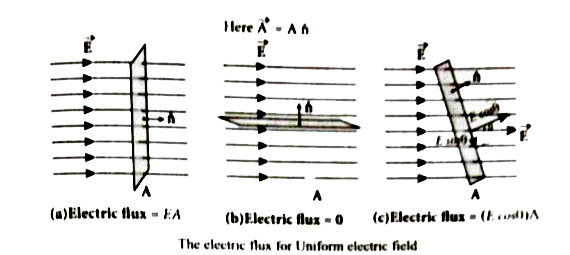 Here, note that `vec(A)` is the area vector `vec(A) = A hat(n)`. Its MAGNITUDE is simply the area A and the direction is along the unit vector `hat(n)` perpendicular to the area. Using this definition for flux. `Phi_(E) = vec(E).vec(A)`.EQUATIONS (2) and (3) can be obtained as special cases. In figure(a), `theta = 0^(@) " so "Phi_(E) = vec(E).vec(A) = EA` In figure (b), `theta = 90^(@) "so" Phi_(1) = vec(E).vec(A) =0` (ii) Electric flux in a non uniform electric field and an arbitrarily shaped area: Suppose the electric field is not uniform and the area A is not flat, then the entire area is divided into n small area segments `Delta vec(A_(1)), Delta vec(A_(2)), Delta vec(A_(3)), ........ Delta vec(A_(n))`, such that each area element is almost flat and the electric field over each area element is considered to be uniform . The electric flux for the entire area A is approximately written as `Phi_(E) = vec(E_(1)) . Delta vec(A_(1)) + vec(E_(2)).Delta vec(A_(2)) + vec(E_(3)).Delta vec(A_(3)) + ....... + vec(E_(n)). Delta vec(A_(n)) = sum_(i = l)^(n) vec(E_(i)). Delta vec(A_(i))`.... (5) By taking the limit `Delta vec(A_(1)) rarr theta` (for all i) the summation in equation (5) becomes integration . the total electric flux for the entire area is given by `Phi_(E) = int vec(E).d vec(A) ""`....(6) From Equation (6), It is clear that the electric flux for a given surface depends on both the electric field pattern on the surface area and orientation of the surface with respect to the electric field. (iii) Electric flux for closed surfaces : In the previous section, the electric flux for any arbitrary curved surface is discussed Suppose a closed surface is present in the region of the non-uniform electric field as shown in figure (a). The total electric flux over this closed surface is written as `Phi_(E) - oint E.d vec(A)""`....(7) 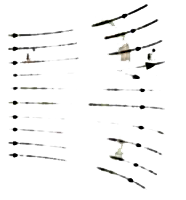 Note the difference between equations (6) and (7) the integration equation (7) is a closed surface integration and for each areal element, the outward normal is the direction of d`vec(A)` as shown in the figure (b). Note the difference between equations (6) and (7) the integration equation (7) is a closed surface integration and for each areal element, the outward normal is the direction of d`vec(A)` as shown in the figure (b). The total electric flux over a closed surface can be negative, Positive or zero. In the figure (b), it is shown that in one area element , the angle between d`vec(A) and vec(E)` is less than `90^(@)`, then the electric flux is positive and in another areal element, the angle between d `vec(A) and vec(E)` is greater than `90^(@)` , then the electric flux is negative. In general, the electric flux is negative if the electric field lines enter the closed surface and positive if the electric field lines leave the closed surface. 
|
|
| 4363. |
The intensity of gamma-"rays" from a given source is I. On passing through 36mm of lead, it is reduced to I/8. The thickness that will reduce the intensity to I/2, it |
|
Answer» 18mm `I=I_(0)=e^(-mux)` `log_(e) 1/I_(0)=-mu x` ...........(i) `log_(e) (I.)/(I_(0))=-mu x. ..........(ii)` From eqn (i) `log_(e) (1/8) =-mux=-36 x..........(iii)` `log_(e) (1/2)=-mu x. .........(IV)` From eqn (iii) `3log_(e) (1/2) =-36X .........(v)` Divide (v) by (iv) `(3 log_(e) ""1/2)/(log_(e) ""1/2)=(-36mu)/(-mu x.)` `3=(12 xx 3)/(x.)` x.=12 mm |
|
| 4364. |
Find the distance of object placed in the slab of refractive index mufrom point P of the curved surface of radius R so that image is formed at infinity : |
|
Answer» `((mu - 1)r)/(mu)` |
|
| 4365. |
How much work is done in moving a 500 muC charge between two points on an equipotential surface? |
|
Answer» |
|
| 4366. |
Which of the following is the infrared wavelength ? |
| Answer» Answer :A | |
| 4367. |
Which of the following statements is not correct? I. Magneitite II. Kaolinite III. Siderite IV. Calamine |
|
Answer» I,II,III II.Kaolinite `to Al_2 Si_2O_5(OH)_4` III. Siderite `to FeCO_3` IV. Calamine `to ZnCO_3` (III), (IV) both are CARBONATE ores. THUS option (d) is correct. |
|
| 4368. |
A mokey is descending from the branch of a tee with constant acceleration. If the the monkey, the minimum acceleration with which monkey can slide down without breaking the branch is |
| Answer» Answer :C | |
| 4369. |
The resistively of a condu is given by the expression : p = RA//l where R is the independent of dimension of conductor it deped on the meters of material and temperature of condections Read the show paragraph and answer the following question: (i) For whichmeterial is the resistivity (i) zero (ii) infinite ? (ii) Find the resistent of a bellow cylindrical of the meterial of cylinderical pipe is 2 xx 10^(-3) Omega m (iii) How is the knowinledge of resistance metel in over dally life ? |
|
Answer» Solution :The resistively is zero for toper conbinations like at critical temperature `4.2K` motion at critical temperature `9.2k` and the resistance is inifnite for a perfect insilner like dry wood and hard glass (i) Here`I = 1.0cm,r_(1)= 0.10m, r_(2)= 0.20 m,rho= 2xxx10^(-6)Omega m` `R=(rhol)/(pi(r_(2)^(2)-r_(1)^(2)))=((2xx10^(-8))xx1)/((22//7)[(0.2)^(2)-(0.1)^(2)])=2.1 xx10^(-7) Omega` (iii) The knowladge of respectively of difference meterial helps as in selecting satable material for differece perposs for example a in making a tranedrelasence cell magain or constant wire is used as in RESISTANCEIS very lange .The length required for a given resistance would be small b in making the heater cell inclinedd wire is used as in resistanceand inclined are high c copper wire are used as CONNECTING wires to electrical experiment of copper is very LOW |
|
| 4370. |
Energy of an electron in an excited state of hydrogen atom is - 3.4 eV. Its angular momentum will be |
|
Answer» `1.11 XX 10^(-34)` JS |
|
| 4371. |
Five identical capacitors, of capacitance 20muF each , are connected to a battery of 150V , in a combination as shown in the diagram . Whatis the total amount of charge stored ? |
|
Answer» `15xx10^(-3)C` 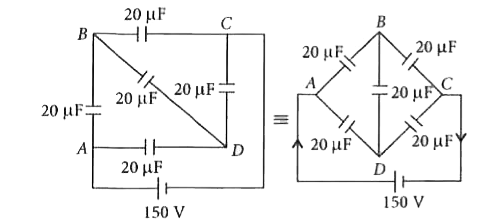 Now at balance condition no current will PASS through BD CONSISTING of `20muF` capacitor. Therefore , EQUIVALENT CIRCUIT will be 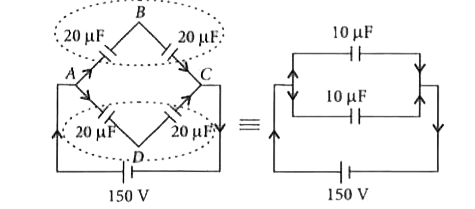 Equivalent capacitance of ABC path = Equivalent capacitance of ADC path `=(20xx20)/(20+20)=(400)/(40)=10MUF` So,equivalent capacitance of the circuit, `C_(eq)=10+10=20muF` `therefor` Total amountof charge stored `=C_(eq)xxV` `=(20xx10^(-6)xx150)=3000xx10^(-6)C=3xx10^(-3)C` |
|
| 4372. |
Calculate the electric anil magnetic fields produced by the radiation coining from a 100 IF bulb at a distance of 3 m. Assume that the efficiency of the bulb is 2.5% and it is a point source. |
|
Answer» Solution : The bulb, as a point source, radiates light in all directions uniformly. At a distance of 3 m, the surface area of the surrounding SPHERE is `A = 4pir^(2)=11 3m^(2)` The intensity at this distance is `I=("power")/("area")=(100 w xx2.5 %)/(113 m^(2))=0.022 W//m^(2)` Half of this intensity is provided by the electric field and half by the magnetic field. `E_(rms)=sqrt(0.022)/(8.85xx10^(-12)(3xx10^(8)))V//m=2.9 V//m` The value of E foiund aboveis the root mean squarevalue of the electricfiedl since the electric fieldin a lightbeam s SINUSOIDAL the pealk electric field `2E_(0)` is `E_(0)sqrt(2E_(rms))=sqrt(2)x2.9V//m` `=4.07 V//m` Thus you see that the electricfieldstrengthof the light that you use for reading is fairly large compare ITWITH electricfield strength of TV or Fm waves which isof the order of a fewmicrovolts pre metre now let uscalculate the strength of themagneticfield it is Again, since the field in the light beam is sinusoidal, the peak magnetic field is `B_(0)=sqrt(2B)_(rms)=1.4 xx10^(-8) T`.Note that although the energy in the magnetic field is EQUAL to the energy in the electric field, the magnetic field strength is evidently very weak. |
|
| 4373. |
Which of the following law is represented by equation given by Maxwell ? |
|
Answer» AMPERE's LAW |
|
| 4374. |
Parallel rays of light from Sun falls on a biconvex lens of focal length f and the circular image of radius r is formed on the focal plane of the lens. Then which of the following statement is correct? |
|
Answer» Area of IMAGE `pir_(2)` directly proportional to f |
|
| 4375. |
In a Young.s interference experimental arrangement, the yellow light is composed of two wavelengths 5890 A^(0)" and "5895 A^(0). The distance between the two slits is 10^(-3)m and screen is placed 1m away. Upto what order can fringes be seen? |
| Answer» ANSWER :A | |
| 4376. |
In a given optical bench, a needle of length 10 cm is used in between (object & lens) and lens and image to estimate bench error. The object needle, image needle & lens holder have their reading as shown. X_0 = 1.1 cm , X_i = 21.0 cm , X_L = 10.9 cm Estimate the bench errors which are present in image needle holder and object needle holder. Also find the focal length of the convex lens when it is given that X_0 = 0.6 cm, X_i = 22.5 cm"" X_L = 11.4 cm |
|
Answer» `2.5 PM 0.05 CM` |
|
| 4377. |
In an oscillating LC circuit, the maximum charge on capacitor is Q. The charge on capacitor when the energy is equally distributed between the electric and magnetic fields is |
|
Answer» `(Q)/(2)` |
|
| 4378. |
Fig. 6.15 shows a current carrying solenoid moving towards a conducting loop. Find the direction of the current induced in the loop. |
| Answer» Solution :As SEEN from the SIDE of SOLENOID the INDUCED current in the loop appears to be flowing in an anticlockwise direction. | |
| 4379. |
In the block moves up with constant velocity v m//s. Find F |
|
Answer» `F=(mg)/(2)` `3F=mg` `F=(mg)/(3)` 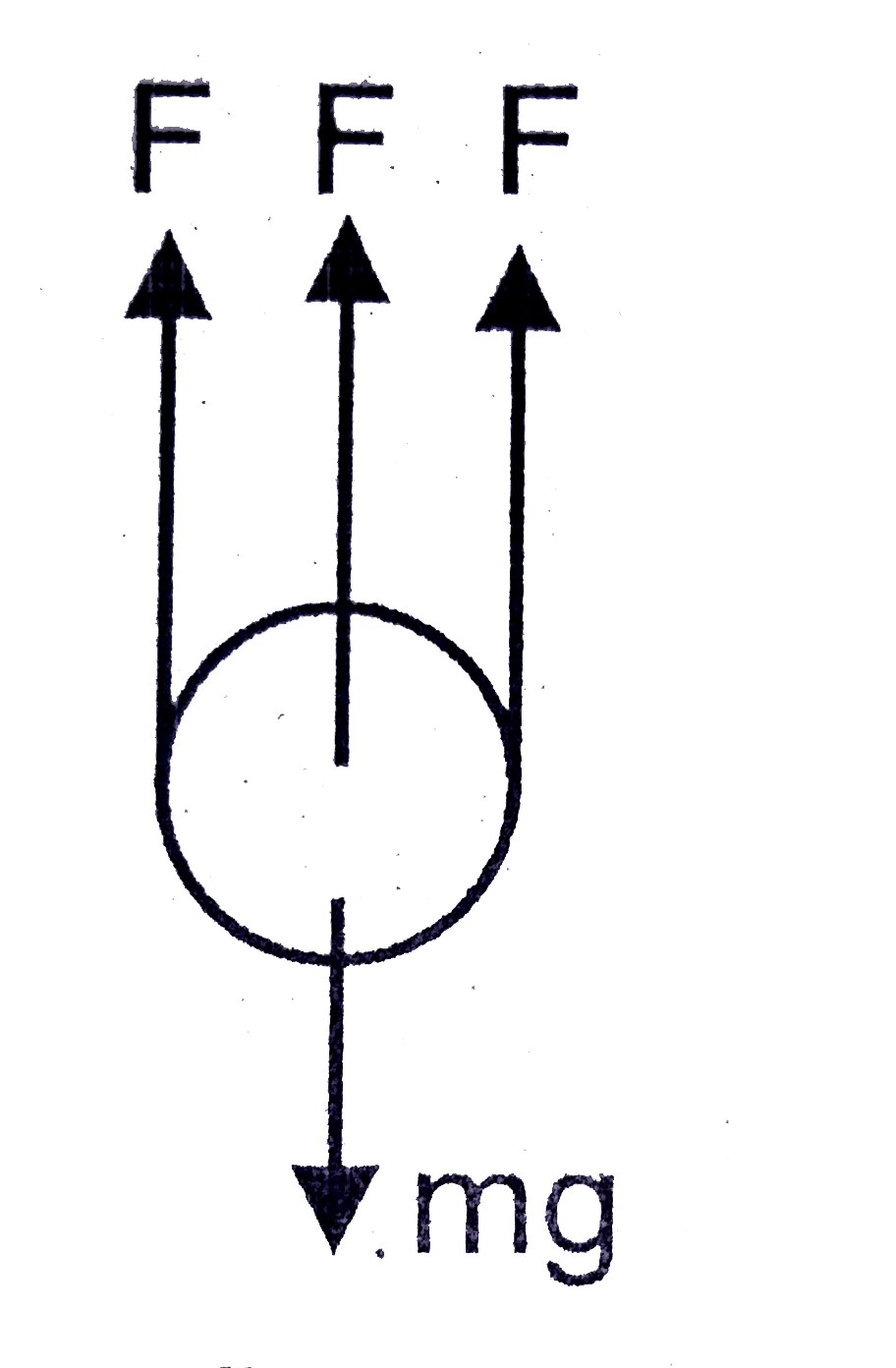
|
|
| 4380. |
AB is a section of a straight wire carrying a current I.P is a point at a distance d from AB . the magnetic field at P due to AB has magnitude : |
|
Answer» `(mu_(0) I)/(4 pi d) (cos theta_(1) + cos theta_(2))` |
|
| 4381. |
Define the ionization energy and ionization potential. |
|
Answer» Solution :The MINIMUM energy required to remove an ELECTRON from an atom in the ground state is known as binding energy or ionization energy. Ionization potential is defined as ionization energy PER UNIT CHARGE. |
|
| 4382. |
In a potentiometer arrangement for determining the emf of a cell, the balance point of the cellin open circuit is 350 cm. When a resistance of 9Omegais used in the external circuit of the cell, thebalance point shifts to 300 cm. Determine the internal resistance of the cell. |
|
Answer» SOLUTION :Here balance point in open circuit `l_1` = 350 cm, balance point in CLOSED circuit` l_2`= 300 cm andexternal resistance R=9`OMEGA` ` therefore ` INTERNAL resistance of the cell`r = (l_1- l_2)/(l_2).R = (350 - 300)/(300) xx 9 = 1.5 Omega` |
|
| 4383. |
In a Young's double-slit experiment the fringe width for dark fringes is different from fringe width for bright fringes. |
| Answer» Solution :False- FRINGE WIDTH for bright fringe=fringe width for DARK fringe `GETA=(lamdaD)/(d)`. | |
| 4384. |
A 300W carrier is modulated to a depth 75%. The total powerin the modulated wave is |
|
Answer» Solution :`P_(C)=300W, MU=75%=0.75` `P_(t)=P_(c)(1+(mu^(2))/(2)) ` o r `P_(t)= 300(1+((0.75)^(2))/(2))= 384W ` |
|
| 4385. |
A current of 8A is to be sent through a resistor of 5Omega Calcualte the least number of cells required for the purpose when each cell has emf 2V and internal resistance 0.5Omega. |
|
Answer» |
|
| 4386. |
The magnification of an object placed in front of a convex lens is +2. The focal length of the lens is 2.0 meters. Find the distance by which object has to be moved to obtain a magnification of – 2 (in meters) |
|
Answer» |
|
| 4387. |
A conducting body 1 has some initial charge Q, and its capacitance is C. There are two other caoducting bodies, 2 and 3, having capacitances :C_(2)=2C and C_(3)rarr oo. Bodies 2 and 3 are initially uncharged. ''Body 2 is touched with body 1. Then, body 2 is removed from body 1 and touched with body 3, and times. Then, the charge on body 1 at the end must be |
|
Answer» `Q//3^(N)` `Q_(1) = (Q)/(3)` after `II^(nd)` operation `Q_(2) = (1)/(3) ((Q)/(3)) = (Q)/(3^(2))` so after `N^(TH)` operation `Q_(N) = (Q)/(3^(N))` |
|
| 4388. |
Which of the following gas can be used in Van de Graaff generator? |
|
Answer» methane |
|
| 4389. |
A prism of mass M is placed on a horizontal surface. A block of mass m slides on the prism, which in tum slides on thehorizontal surface. Assuming all surfaces to be frictionless, find the acceleration of block with respect to prism. |
|
Answer» Solution :Let `a_0` be the acceleration of PRISM in the backward direction. The mass .m. is placed on non-inertial FRAME, therefore it is acted on by fictitious FORCE `ma_0` in the forward direction. The forces acting on massm are i) Weight mg acting downward, 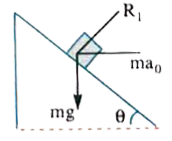 ii) Normal REACTION R, iii) Fictitious force `ma_0` According free body diagram of .m. is shown in figure. Suppose block m slides down the prism with acceleration a. The equation of motion of .m. parallel to incline is `ma_0 cos theta + mg sin theta = ma ` `implies a = a_0 cos theta + g sin theta ` ........... (1) The block is in equilibrium perpendicular to incline, so resolving force perpendicular to incline  `R_1 + ma_0 sin theta = mg cos theta ` ........ (2) Now we consider the forces acting on the prism. As prism is on ground (inertial frame) no fictitious force acts on it. The forces on prism are i) Weight (Mg) downward. ii) Normal force `R_1` exerted by block iii) Normal reaction `R_1` exerted by ground For horizontal motion of prism `R _1sin theta = Ma_0 implies R_1 = (Ma_0)/(sin theta ) `......... (3) substituting this value in (2) , `(Ma_0)/(sin theta) + ma_0 sin theta = mg cos theta ` This gives ` a_0 = ( mg sin theta cos theta)/( M + m sin^(2) theta ) `............ (4) `:. ` From (1) , ` a=(mg sin theta cos^(2) theta )/( M + m sin^(2) theta ) + g sin theta ` `= ((M+m) g sin theta )/( M + m sin^2 theta )` |
|
| 4390. |
A young.s double slit experiment uses a monochromatic source. The shape of interference fringes formed on a screen is |
|
Answer» STRAIGHT line |
|
| 4391. |
In a Lithium atom there is one electron in second orbit. The interaction of this electron with the two inner electrons can be accounted for by assuming that this electron (the electron in second orbit) sees a nuclear attraction of Z' protons (where Z' lt Z = 3). Experimentally, it is known that 5.39 eV of energy is needed to remove the outermost electron from the atom. (a) Find Z' (b) Find the longest wavelength of photon that can be absorbed by the electron in n = 2 state. |
|
Answer» |
|
| 4392. |
Define ohm. |
|
Answer» SOLUTION :The RESISTANCE of a CONDUCTOR is said to be one ohm, if one volt of p.d. across its ends causes one ampere of current in it. `R = V/T ,` one ohm `=("one volt")/("one ampere")` |
|
| 4393. |
A spherical convex surface of radıus of curvature 20 cm, made of glass (mu= 1.5) is placed in air Find the posıtion of the image formed, if a point object is placed at 30 cm in front of the convex surface on the principal axis. |
|
Answer» 1.0/v-1.5/030=(1.0-1.5)/20 v=-13.3 CM |
|
| 4394. |
Thin threads are tightly wound on the ends of a uniform solid cylinder of mass m. The free ends of the threads are attached to the ceiling of an elevator car. The car starts going up with an acceleration w_0. Find the acceleration w^' . Find the acceleration w^' of the cylinder relative to the car and the force F exerted by the cylinder on the ceiling (through the threads). |
|
Answer» SOLUTION :Let us depict the forces and their points of application corresponding to the cylinder attached with the elevator. Newton's second law for solid in VECTOR form in the frame of elevator, gives: `2vecT+mvecg+m(-vecw_0)=mvecw` (1) The equation of moment in the C.M. frame relative to the cylinder axis i.e. from `N_z=I_cbeta_z`. `2TR=(mR^2)/(2)beta=(mR^2)/(2)(w^')/(R)` [as thread does not slip on the cylinder, `w^'=betaR`]  or, `T=(mw^')/(4)` As (1) `vecTuarrdarrvecw` so in vector form `vecT=-(mvecw)/(4)` (2) Solving Eqs. (1) and (2), `overset(rarr')w=2/3(vecg-vecw_0)` and SOUGHT force `vecF=2vecT=1/3m(vecg-vecw_0)` |
|
| 4395. |
In the circuit shown in figure (a), the emf of the ideal cell is E = 100 V and resistance R is 10 Omega. The current (I) – Voltage (V) characteristic of the circuit contained in box A is as shown in figure (b). find the potential difference across the box A. |
|
Answer» |
|
| 4396. |
Two charges 2 C and 3 C are located 100 m apart. At what point on the line joining the two charges is the electric potential zero ? Take the potential at infinity to be zero. . |
| Answer» SOLUTION :X -40 m and x = - 200 m | |
| 4397. |
A radioactive material has a half life of 1 minute. If one the nuclie decaysnow, when will the next one decay? |
| Answer» SOLUTION :The NEXT NUCLEUS can DECAY any TIME. | |
| 4398. |
Helium nuclei combine to form an oxygon nucleus. Calculate the binding energy per nucleon of oxygen nucleus, if m_0=" 15.834 amu, "m_(He)= 4-0026 a.m.u. : |
|
Answer» 4MeV `4_(2) He^(4) =4 xx 4.0026=16.0104 a.m.u.` `""_(8)O^(16)=15.834 a.m.u.` `trianglem=0.1764 a.m.u.` B.E/nucleon `=(trianglem)/(A)=(0.1764 xx 931)/(16)=10.26 MEV` |
|
| 4399. |
A parallel plate capacitor having a separation between the plates d, plate area A and material with dielectric constant K has capacitance C_0 . Now one-third of the material is replaced by another material with dielectric constant 2K, so that effectively there are two capacitors one with area 1/3 A, dielectric constant 2K and another with area 2/3 A and dielectric constant K. If the capacitance of this new capacitor is C then C//C_0 is : |
|
Answer» `1` |
|
| 4400. |
The V versus xplot for six identicalmetal plates of cross-sectionalarea A is as shown. The equivalent capacitancebetween 2 and 5 is (Adjacent plates are placed at a separation d) : |
|
Answer» `(2 in_(0)A)/(d)` |
|